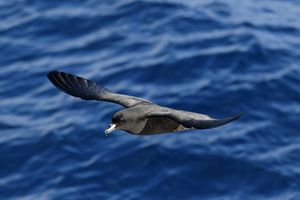طائر النوء
طائر النوء Petrel هو طائر بحري أنبوبي المنقار في رتبة الطيور نوئيات Procellariiformes.
الوصف
The common name does not indicate relationship beyond that point, as "petrels" occur in three of the four families within that group (all except the albatross family, Diomedeidae). Having a fossil record that was assumed to extend back at least 60 million years, the Procellariiformes was long considered to be among the older bird groupings, other than the ratites, with presumably distant ties to penguins and loons. However, recent research and fossil finds such as Vegavis show that the Galliformes (pheasants, grouse and relatives), and Anseriformes (ducks, geese) are still not fully resolved.
الأنواع المعروفة
All the members of the order are exclusively pelagic in distribution—returning to land only to breed.
The family Procellariidae is the main radiation of medium-sized true petrels, characterised by united nostrils with medium septum, and a long outer functional primary. It is dominant in the Southern Oceans, but not so in the Northern Hemisphere.
It includes a number of petrel groups, the relationships between which have finally been resolved to satisfaction.[1][2][3][4]
- The fulmarine petrels: seven species of surface predators and filter feeders, breed in high latitudes but migrate along cool currents to the north. All but Fulmarus are essentially confined to the south, Fulmarus apparently colonised the Northern Hemisphere during the Early Miocene.
- The huge giant petrels, genus Macronectes, which are convergent with the albatrosses
- The true fulmars, genus Fulmarus
- Antarctic petrel Thalassoica antarctica
- Cape petrel Daption capense
- Snow petrel Pagodroma nivea
- The prions: A specialised group of a few very numerous species, all southern. They have a small, fulmar-like form and mostly filter-feed on zooplankton.
- Pachyptila, the prions proper
- The procellariine petrels, larger or mid-sized species feeding on fish and molluscs which are fairly close to the prions:
- Shearwaters: There are numerous species in several genera with a medium number of species.
- Calonectris
- Puffinus, which is two rather distinct groups of larger and smaller species
- Pseudobulweria
- Kerguelen petrel Lugensa brevirostris
- The gadfly petrels: These are a considerable number of agile short-billed petrels in the genus Pterodroma which include the endangered Bermuda petrel or cahow and a considerable number of forms rendered extinct by human activity.
The families Oceanitidae and Hydrobatidae are the storm petrels, small pelagic petrels with a fluttering flight which often follow ships.
The family Pelecanoididae is the four species of diving petrels, genus Pelacanoides. These are auk-like small petrels of the southern oceans.
The word petrel comes from the Latin name for the Christian Saint Peter, and refers to the habits of certain species to hover just above the ocean waves, with their feet barely touching the water, thus giving an appearance of walking on water, as St. Peter is said to have done.
انظر أيضاً
الهامش
- ^ Austin, Jeremy J. (1996). "Molecular Phylogenetics of Puffinus Shearwaters: Preliminary Evidence from Mitochondrial Cytochrome b Gene Sequences". Molecular Phylogenetics and Evolution. 6 (1): 77–88. doi:10.1006/mpev.1996.0060. PMID 8812308.
- ^ Bretagnolle, V., Attié, C., Pasquet, E. (1998). "Cytochrome-B evidence for validity and phylogenetic relationships of Pseudobulweria and Bulweria (Procellariidae)" (PDF). Auk. 115(1: 188–195. doi:10.2307/4089123.
{{cite journal}}: CS1 maint: multiple names: authors list (link) - ^ Nunn, Gary B.; Stanley, Scott E. (1998). "Body Size Effects and Rates of Cytochrome b Evolution in Tube-Nosed Seabirds" (PDF). Molecular Biology and Evolution. 15 (10): 1360–1371. doi:10.1093/oxfordjournals.molbev.a025864. PMID 9787440.
{{cite journal}}: Unknown parameter|lastauthoramp=ignored (|name-list-style=suggested) (help) Corrigendum - ^ Brooke, M. (2004): Albatrosses and Petrels Across the World. Oxford University Press, Oxford, UK. ISBN 0-19-850125-0
وصلات خارجية
 The Wiktionary definition of petrel
The Wiktionary definition of petrel- Petrel and shearwater videos on the Internet Bird Collection
- Agreement on the Conservation of Albatrosses and Petrels (ACAP)
